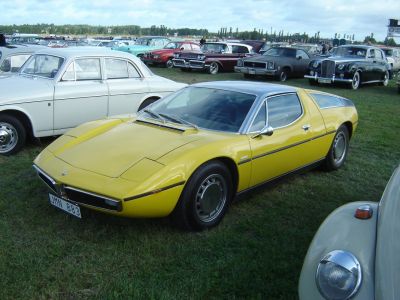 1982 Lotus Excel Dimensions, Size & Specs
1982 Lotus Excel Dimensions, Size & SpecsMeasurements of the 1982 Lotus Excel, engineered for optimal performance and comfort
| Dimensions | |
|---|---|
| Length: | 4395 mm173.0 in14.4 ft |
| Width: | 1815 mm71.5 in6.0 ft |
| Height: | 1205 mm47.4 in4.0 ft |
| Trunk Capacity: | 370 liter13.1 cu ft |
| Weight Specifications | |
| Curb Weight: | 1135 kg2502 lbs |
| Tire Specifications | |
| Rims Size: |
|
| Tire Size: |
|
The Lotus Excel, produced from 1983 to 1991, represents a distinctive British sports coupe that blends performance with refined design and practical dimensions. Launched in 1982 as a successor to the Lotus Eclat, the Excel maintained the classic coupe silhouette with a notably low height of 1205 mm (47.4 inches), emphasizing aerodynamic efficiency and a sporty stance. With a length of 4395 mm (173 inches) and width of 1815 mm (71.5 inches), the Excel provided a compact yet comfortable footprint, suitable for an agile sports car. Its curb weight of 1135 kg (2502 lbs) contributed to the vehicle's spirited driving dynamics, delivering an engaging driving experience typical of Lotus engineering. Despite its sports car focus, the Excel offered a respectable luggage capacity of 370 liters (about 13 cubic feet), making it practical for weekend trips and daily use. The vehicle rode on 15-inch rims fitted with 215/50 R15 tires, ensuring good grip and road handling characteristics while maintaining classic styling. The Lotus Excel remains a noteworthy example of 1980s sports coupe design with balanced proportions, a lightweight chassis, and adequate cargo space, setting it apart in the sports car segment of its era.
Discover the standout features that make the 1982 Lotus Excel a leader in its class
Have a question? Please check our knowledgebase first.
The Lotus Excel, produced from 1983 to 1991, has carefully balanced dimensions that contribute to its sporty design and performance. Its length measures 4395 mm (approximately 173 inches), providing a compact yet substantial presence on the road. The width is 1815 mm (about 71.5 inches), offering good stability and a broad stance. The height stands at 1205 mm (around 47.4 inches), contributing to a sleek coupe profile that enhances aerodynamics. These dimensions collectively give the Excel its agile handling and distinctive appearance typical of Lotus sports cars from that period.
The curb weight of the Lotus Excel (1983-1991) is approximately 1135 kg, which is about 2500 pounds. This relatively light weight for a sports coupe is a key factor in the car's sharp handling and nimble driving characteristics. Lotus has always emphasized lightweight construction to improve acceleration, braking, and cornering. The 1135 kg curb weight helps the Excel maintain an excellent power-to-weight ratio, enhancing its responsiveness and overall driving dynamics, allowing for a more engaging driving experience typical of Lotus vehicles.
The Lotus Excel offers a luggage capacity of 370 liters, which is fairly generous for a sports coupe of its time. This capacity translates to roughly 13.1 cubic feet, providing adequate space for luggage, groceries, or small sports equipment. The hatchback-style rear liftgate opens to reveal a practical cargo area, making the Excel suitable for weekend trips or daily commuting where moderate luggage space is needed. While the interior is focused on performance and driver engagement, the luggage space adds a layer of utility that enhances its practicality compared to typical two-seat sports cars.
Yes, the Lotus Excel fits comfortably into a standard residential garage due to its compact dimensions. With a length of 4395 mm (173 inches), a width of 1815 mm (71.5 inches), and a height of just 1205 mm (47.4 inches), it is smaller than many modern sports coupes, which often exceed these dimensions. Most standard garages, typically around 2.4 to 3 meters wide and 5 to 6 meters deep, can easily accommodate the Excel. The relatively low height also facilitates clearance under standard garage doors and in multi-level parking structures, making it convenient for everyday storage.
The Lotus Excel is equipped with 15-inch rims paired with 215/50 R15 tires, a combination that balances grip, ride comfort, and handling precision. The 215 mm width provides a good contact patch for traction and cornering stability, while the 50-profile tire sidewall offers a compromise between responsive steering feedback and shock absorption over road imperfections. This setup contributes significantly to the Excel's nimble and balanced handling, typical of Lotus’ sports cars. It allows the car to maintain stability during high-speed maneuvers and provides excellent road-holding without sacrificing ride comfort excessively.
The Lotus Excel is a natural evolution from its predecessor, the Lotus Eclat, which was produced from 1975 to 1982. In terms of size, the Excel retained a similar footprint but introduced refinements for improved aerodynamics and styling. The Excel’s length is 4395 mm (173 inches), which is slightly longer than the Eclat that measured around 4330 mm (170.5 inches), giving the Excel a bit more presence and interior space. Width and height remained largely comparable, maintaining the low-slung coupe proportions. Overall, these size adjustments enhanced the Excel's performance and practicality without significantly altering its compact sports car character.
When compared to other sports coupes from the 1980s, the Lotus Excel holds its own as a compact yet well-proportioned vehicle. Many sports coupes of that era, such as the Porsche 944 or the BMW E24 6 Series, generally featured similar lengths around 4.3 to 4.6 meters (169 to 181 inches) but sometimes wider or taller profiles. The Excel’s 1815 mm width (71.5 inches) and notably low height of 1205 mm (47.4 inches) make it lower and slightly narrower than many rivals, emphasizing its aerodynamic and lightweight sporting intent. This gives the Excel a unique niche, blending size with agility and classic British sports car design.
Despite the Lotus Excel's low height of 1205 mm (47.4 inches), the interior is designed to optimize headroom and driver comfort for a sports coupe. The car accommodates two occupants comfortably with a focus on driver-centric ergonomics. The roofline arches thoughtfully to provide adequate headroom, though taller drivers may experience a snug fit typical of vehicles with a low-slung profile. Legroom and shoulder space benefit from the car’s width of 1815 mm (71.5 inches), allowing for a relatively roomy cabin for its class. The Excel balances sporty compactness with enough interior room for enjoyable daily driving or spirited weekend excursions.
The Lotus Excel's design incorporates several elements that contribute to its compact dimensions while emphasizing sporty performance. The car features a sleek wedge-shaped profile with smooth, flowing lines that reduce aerodynamic drag. Its mid-long bonnet and greenhouse design cleverly allocate interior space without extending overall length excessively. Large glass surfaces in the front and rear enhance visibility while keeping weight down. Additionally, the integrated rear spoiler and subtle front air dam highlight its racing-inspired styling. The use of lightweight materials further ensures that the Excel remains nimble and responsive, showcasing Lotus' commitment to design and engineering excellence.
Beyond its compact and well-considered size, the Lotus Excel (1983-1991) is renowned for its engineering that blends reliability with sports car enthusiasm. It is powered by a 2.2-liter 4-cylinder engine (based on the Toyota 22R block) tuned by Lotus to produce sporty power output, coupled with a 5-speed manual transmission. The Excel's chassis features bonded aluminum construction, which was advanced for its time, delivering a stiff and lightweight structure. This, combined with fully independent suspension and precise rack-and-pinion steering, results in sharp handling and a connected driving experience. These aspects make the Excel a practical yet engaging vehicle for driving enthusiasts.
Discover similar sized cars.

| Production: | 1972-1980 |
|---|---|
| Model Year: | 1971 |
| Length: | 4335 mm170.7 in |
| Width: | 1768 mm69.6 in |
| Height: | 1134 mm44.6 in |

| Production: | 2008-2013 |
|---|---|
| Model Year: | 2005 |
| Length: | 4435-4475 mm174.6-176.2 in |
| Width: | 1845-1928 mm72.6-75.9 in |
| Height: | 1237-1245 mm48.7-49.0 in |
